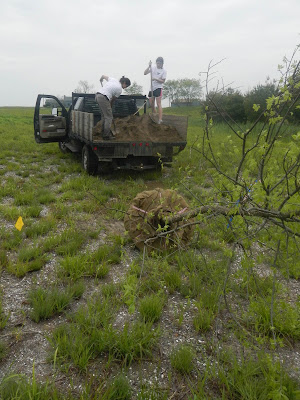Habitat management of the remediated upland recently involved a prescribed burn to remove a thatch layer that had been building for several years. Encroaching invasive plant species are tackled as they crop up and last week's planting session is a next step towards fighting the unwanted and unsuited plants in the area and gradually replacing them with native vegetation that historically would have occurred in the area.
 |
| SHU graduate student Jennifer Gazerro provides directions to her crew as they stake out the exact locations of the new plantings in one of the four vegetation 'islands' |
Previous vegetation surveys at Stratford Point during the summer of 2011 have provided a solid baseline assessment of the habitat prior to all the work that is being done, while similar surveys in high quality coastal habitat at our coastal center on Milford Point help us understand what a desired restoration outcome could be. Hopefully the new plants will put us another step closer to re-creating a functional coastal habitat.
Native trees and shrub, such as Red Bearberry (Arctostaphylos uva-ursi), Eastern Red Cedar (Juniperus virginiana), Serviceberry/Shadbush (Amelanchier canadensis), Southern Arrowwood (Viburnum dentatum), Hackberry (Celtis occidentalis), Northern Bayberry (Myrica pensylvanica), Beach Plum (Prunus maritima) and Staghorn Sumac (Rhus typhina), were planted in four identical, circular vegetation 'islands.' This configuration allows us to carry out specific monitoring studies to compare the well-being of plants in each 'island' as a result of different environmental conditions. In addition, it is easier to protect clusters of vegetation rather than scattered individual plants from deer browsing.
 |
| Sacred Heart University students work hard to dig a large enough hole to accommodate the tree that CAS Sanctuary Manager John Laiacone is bringing over. |
 |
| CAS Conservation Technician Scott Kruitbosch is distributing shrubs to their designated spots |
 |
| The SHU Biology Department van was turned into a green delivery vehicle |
 |
| A soil/compost mixture left over from the dune construction project carried out earlier this year is used as planting medium for the new trees |
 |
| Many hands made the planting project manageable and by the end of the day all 96 trees and shrubs were in the ground |
Twan Leenders
Conservation Biologist
All
photos © Twan Leenders and not to be reproduced without explicit
permission


Habitat management of the remediated upland recently involved a prescribed burn to remove a thatch layer that had been building for several years.Online Nursery
ReplyDelete